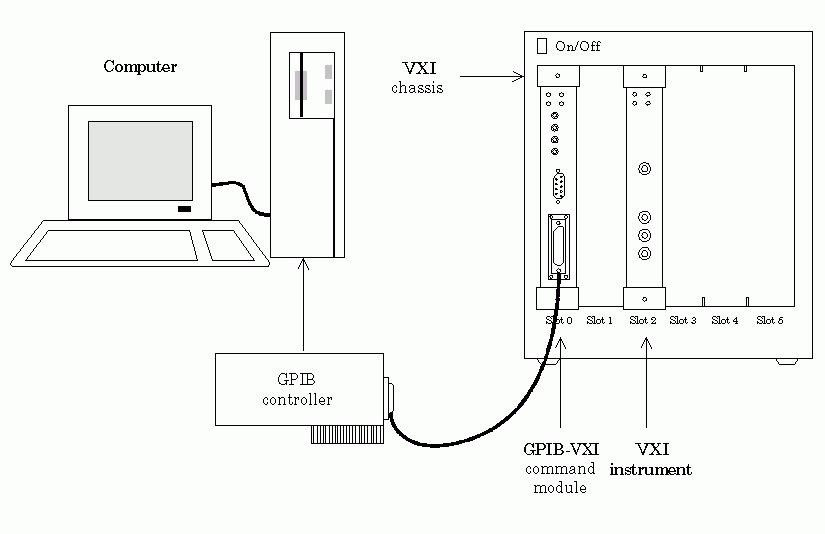

| Instrument Control Toolbox |   |
The GPIB-VXI Interface
The GPIB-VXI interface is associated with a GPIB-VXI command module that you install in slot 0 of a VXI chassis. This interface, along with the other relevant hardware, is shown below.

The GPIB-VXI interface is supported through a VISA-GPIB-VXI object. The features associated with a VISA-GPIB-VXI object are similar to the features associated with GPIB and VISA-VXI objects. Therefore, only functions and properties that are unique to VISA's GPIB-VXI interface are discussed in this section. These unique features are associated with:
Refer to Chapter 3, Controlling GPIB Instruments to learn about writing and reading text and binary data, using events and actions, using triggers, and so on. Refer to Register-Based Communication to learn about accessing VXI registers.
Note
The VISA-GPIB-VXI object does not support the spoll and trigger
functions, or the BusManagementStatus, HandshakeStatus, InterruptAction,
TriggerAction, TriggerLine, and TriggerType properties.
|
Creating a VISA-GPIB-VXI Object
You create a VISA-GPIB-VXI object with the visa function. As shown in the preceding figure, each object is associated with:
visa requires the vendor name and the resource name as input arguments. The vendor name is either agilent or ni. The resource name consists of the VXI chassis index and the instrument logical address. You can find the VISA-GPIB-VXI resource name for a given instrument with the configuration tool provided by your vendor, or with the instrhwinfo function. As described in Configuring Properties During Object Creation, you can also configure property values during object creation.
For example, to create a VISA-GPIB-VXI object associated with a VXI chassis with index 0, an Agilent E1406A Command Module in slot 0, and an Agilent E1441A Arbitrary Waveform Generator in slot 2 with logical address 80
vgv = visa('agilent','GPIB-VXI0::80::INSTR');
The VISA-GPIB-VXI object vgv now exists in the MATLAB workspace. You can display the class of vgv with the whos command.
whos vgv Name Size Bytes Class vgv 1x1 644 visa object Grand total is 18 elements using 644 bytes
After you create the VISA-GPIB-VXI object, the properties listed below are automatically assigned values. These properties provide descriptive information about the object based on its class type and address information.
| Property Name |
Description |
Name |
Specify a descriptive name for the VISA-GPIB-VXI object. |
RsrcName |
Indicate the resource name for a VISA instrument. |
Type |
Indicate the object type. |
You can display the values of these properties for vgv with the get function.
get(vgv,{'Name','RsrcName','Type'})
ans =
'VISA-GPIB-VXI0-80' 'GPIB-VXI0::80::INSTR' 'visa-gpib-vxi'
The VISA-GPIB-VXI Object Display
The VISA-GPIB-VXI object provides you with a convenient display that summarizes important address and state information. You can invoke the display summary these three ways:
The display summary for the VISA-GPIB-VXI object vgv is given below.
VISA-GPIB-VXI Object Using AGILENT Adaptor : VISA-GPIB-VXI0-80 Communication Address ChassisIndex: 0 LogicalAddress: 80 Communication State Status: closed RecordStatus: off Read/Write State TransferStatus: idle BytesAvailable: 0 ValuesReceived: 0 ValuesSent: 0
 | Register-Based Communication | The VISA-GPIB-VXI Address |  |